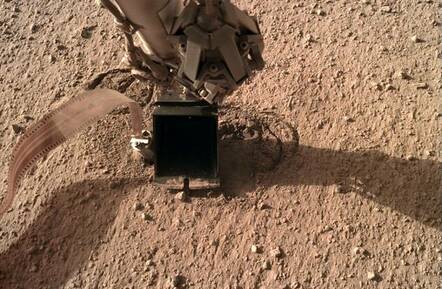This article is more than 1 year old
You're getting warmer: NASA's thermal mole reveals active mantle plume on Mars
Discovery shows 'astrobiological potential of subsurface habitable environments'
Researchers have discovered a driver for volcanic activity on Mars, a red planet once thought to have no active seismic geology.
Using data from NASA’s InSight probe, which first landed on the fourth planet from the Sun in 2018, planetary scientists from the University of Arizona’s Lunar and Planetary Laboratory have deduced an active mantle plume, the same type of giant pillar of hot molten rock which drives volcanic activity and earthquakes on Earth by pushing hot magma from the mantle to nearer the surface crust.
Their data model suggests the plume has a diameter of about 4,000km and lies below the northern plains of Mars. Located in the Elysium Planitia region, the plume could explain the area's volcanic and seismic activity, the research paper published today in Nature Astronomy said.
Although there is plenty of evidence of volcanic activity on the Martian surface, including the largest volcano in the solar system, Olympus Mons, most of this activity took place during a 500-million-year period about 4 billion years ago.
But in 2015, NASA set in place plans to build a probe which could reveal more about geological activity on Earth's proximal sidekick. In 2018, the resulting $810 million InSight lander touched down, with an instrument called HP3, a thermal “mole” that “will hammer five meters into the Martian subsurface … to learn how much heat is coming from Mars' interior and reveal the planet's thermal history.”
Analyzing the resulting data, and combining it with other sources including gamma-ray spectrometer data from NASA’s Mars Odyssey spacecraft, Adrien Broquet, postdoctoral research associate, and associate professor Jeffrey Andrews-Hanna found strong evidence for ongoing geological activity.
- Origins of mysterious marsquake settled: It was a meteoroid what done it
- US Air Force announces plan to assassinate molluscs with hypersonic missile
- The volcanoes on Venus aren't dead, say astroboffins, they're merely resting, pining for the planet's lava fjords
- Please be aliens, please be aliens, please be aliens... Boffins discover mystery mass beneath Moon's biggest crater
They found Cerberus Fossae, where Insight touched down, sits over a mantle plume of hot material that is 95–285 Kelvin warmer than its surroundings. The presence of an active plume drives local sustained geological activity, including the marsquakes detected by InSight, and is the cause of the slow opening of the crust beneath the Cerberus Fossae.
“Ongoing plume activity demonstrates that Mars is not only seismically and volcanically active today, but possesses a geodynamically active interior as well. A plume beneath Elysium Planitia also indicates that the surface volcanic flows and seismic activity are not isolated events, but part of a long-lived, actively sustained, regional system, with implications for the longevity and astrobiological potential of subsurface habitable environments,” the research paper said.
The researchers noted that the findings suggest that Mars is only the third body in the inner Solar System, after the Earth and Venus, with currently active mantle plumes. ®

